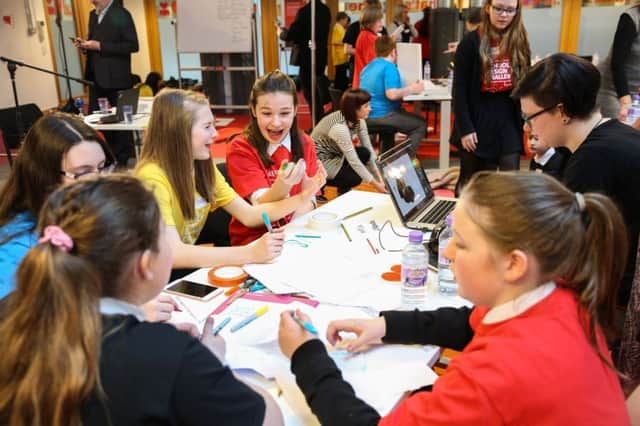Grand designs: How 1,000 pupils won through


Creativity and innovation are critical to the future of Scotland, but can creative ways of thinking be taught? How can our schools empower and enable Scotland’s young people to feel confident about tackling the major problems the world faces?
We passionately believe that creativity can be taught, that creative thinking is a structured process that anyone can learn, and that teaching design skills inspires creativity right across the curriculum. How artistic you are, and the skills you have, are not relevant to your creative potential or your ability to solve problems.
Advertisement
Hide AdAdvertisement
Hide AdFor V&A Dundee’s Schools Design Challenge we put these ideas to the test, with the help of more than 1,000 energetic, enthusiastic secondary pupils from Angus and Dundee. We asked them to consider ways of improving their schools or school lives, and they worked with teachers to develop their ideas.
More than 250 teams submitted creative responses to the challenge, which included designing a friendship club, an outdoor bird-watching shelter, an anti-bullying robot that listens to pupils’ concerns, and a “worry app” to let pupils report their anxieties and seek support.
While the ideas covered a wide range of themes, many focused on the often difficult transition from primary to secondary school – and all offered very honest, informed and impassioned insight into the hopes and fears of Scotland’s young people.
What was common across every submission – and quite overwhelming to both of us (an experienced secondary teacher and a museums professional) – was the creativity the young people showed, regardless of their educational ability.
The design process the pupils engaged in drew on our experiences of both formal and informal learning, and importantly focused on the process itself rather than the skills often associated with creativity in the arts or design, such as drawing. Removing barriers to unlocking creativity was key to the project’s success, and to this approach encouraging genuine learning across subject disciplines.
What moved us most was how the young people came alive when their contributions were valued on an even level, and how some of the key approaches of any designer – researching a problem, collecting a wide range of ideas and inspirations, then refining those ideas and prototyping solutions – released the pupils from their own self-imposed constraints and expectations.
For designers, particularly in the early stages of finding a problem to solve, there can be no wrong answers – or wrong questions. To limit your collection of information based on any assumption or personal bias just leads to poor design solutions, and to products or services being created that nobody wants or needs.
This can be a very difficult idea for anyone, of any age, to embrace. It can feel contrary to our own expectations of how the world works, and even challenge our sense of self-importance about being an “expert” in any given area of life. But only once you split apart the process of finding a problem from the process of designing a solution can creativity really take hold.
Advertisement
Hide AdAdvertisement
Hide AdThe importance of this for Scotland’s young people cannot be overstated, particularly as they move from primary to secondary school and the intensity of peer pressure grows. Our young people need to understand the value of their ideas and their enormous creative potential – and teaching design skills is one important way to do that, for any school subject.
The work of V&A Dundee has benefited hugely from an exciting and unique educational partnership. Working with Dundee City Council, the museum is jointly developing its learning programme with teaching professionals seconded over a ten-year period.
This has allowed V&A Dundee to create an innovative approach to combine the best of formal and informal learning, ultimately to the benefit of our pupils and their understanding of their own creative potential.
But this is just the start for our museum’s work in schools and with young people across Scotland. The museum itself will be a source of inspiration and education for people of all ages, showing how Scotland’s designers have shaped the world, and building on the work we’ve been doing in communities since 2014.
From the ideas we received, ten exceptional teams were selected to work with professional designers to develop their thinking further and produce prototypes. Their work will go on show at an exhibition from next week in Dundee’s Overgate Shopping Centre.
The exhibition is another way that we’re showing these pupils how much we value their creativity. They have all become designers through working with V&A Dundee, and have seen how they can creatively find solutions in a clear, structured way, regardless of their educational attainment to this point.
We believe that this is the real power of design – to let people see that the problems in the world around them are ready to be solved. And no-one is more important to our future than the young people who will shape the future of Scotland and the wider world.
• Joanna Mawdsley is learning manager for schools, young people and families at V&A Museum of Design Dundee. Sandy Hope is the seconded schools development officer. • The Schools Design Challenge exhibition will be held in Dundee’s Overgate Shopping Centre from 14-27 March, on the first floor outside Debenhams.
• Find out more at www.vandadundee.org
SEE ALSO